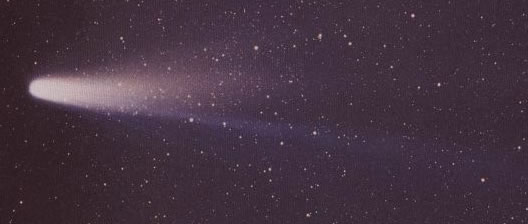Advertisement
This page tells all about the 76-year cycle of Halley's Comet.

About Comets
Halley's Comet is the best-known of the periodic comets. A comet is a small body that orbits the sun. A comet is made of a coma, nucleus, and a tail. The coma surrounds the nucleus and is made of carbon dioxide, water vapor, and other gas. The nucleus is made of solid ice, rock, and dust. The tail is comprised of dust and ionized gases and may extend for millions of miles. The nucleus of Halley's Comet is thought to extend about 9 miles in length and a little less than five miles in width. Its tail, however, may extend for tens of millions of miles. Currently, there are about 3,650 identified comets.
Halley's is a Periodic Comet
A periodic comet (also called short-period comet) is a kind of comet that has an orbital period of less than 200 years. Halley's Comet is the only periodic comet to be visible to the human eye that can be seen twice in one lifetime. It was named after the famous astronomer Edmund Halley, who calculated its orbit in 1682. The comet itself had been seen for many centuries prior to Halley's calculations, but had not been recognized as a periodic comet. Halley's Comet last appeared in 1986 and will re-appear sometime in 2061.
The Oort Cloud and Kuiper Belt
It is thought that Halley's Comet originated in an area of space called the Oort Cloud. The Oort Cloud is a massive area of cometary bodies nearly a full light year away from the sun. Most similar comets originate in the closer Kuiper Belt, an area of dwarf planets, comets, and icy bodies controlled by the gravity of Neptune. Scientists, however, believe that Halley's Comet was originally a long period comet.
1835 to 1910 to 1986
The much anticipated 1986 viewing of the comet was disappointing to many observers and certainly much less spectacular than other described observations recorded in 1910 (from which the first photographs of the comet exist) and 1835 (from which Mark Twain joked that 'he came in with it' and expected to 'go out with it'. Sure enough, Twain died in 1910). Lights from increased urbanization served to decrease the brightness of the comet, and the comet apparently achieved its maximum brightness in the southern hemisphere.
Related activities
Advertisement

